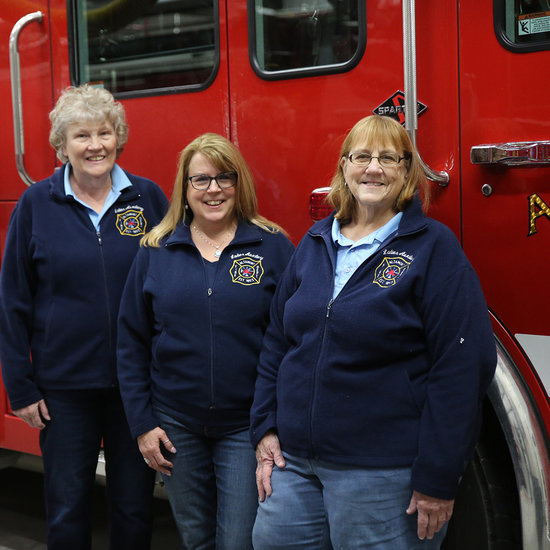AFD Ladies’ Auxiliary disbands as women invade man’s world
ALTAMONT — Many of the women who supported the men who fought village fires have pressed on to fight fires themselves.
Both Dorothy Crupe Ernest and Teresa Freeman, longtime members of the Ladies’ Auxiliary of the Altamont Fire Department, think it’s fantastic that women have gone from supporting men to standing shoulder to shoulder with them fighting fires — both Ernest and Freeman have become exterior firefighters.
Six women are now involved in the firematic side of the department, Ernest and Freeman said, though not all were members of the ladies’ auxiliary — four transferred over as either firematic or social members.
“It’s a man’s world,” Ernest said.
“Yup, it is,” Freeman said in agreement. “And we’re invading it.”
Earlier this month, after nearly eight decades, the Ladies’ Auxiliary of the Altamont Fire Department disbanded.
Because “there’s just so few of us, and it was always the same couple [of] people doing everything … we couldn’t get membership,” explained Ernest, the most recent president of the auxiliary. “It’s just, it was lack of interest. I mean, people are so busy nowadays. I get it. They don’t want to devote time to it, but it just got to the point where we said, ‘This just isn’t going to work anymore.’”
Ernest said the auxiliary had as many as 20 members at one time in her over three decades of membership. At its disbandment, the auxiliary had about seven.
Freeman expanded on Ernest’s point that volunteerism is now at an all-time low. “People are busy,” she said. “Back in the day when this ladies’ auxiliary was developed, you got to remember these were housewives. They were home.”
She continued, “Now you have both a husband and wife … working, working long hours. And it’s very hard for people to want to commit because it does take time. It takes time out of your after-hours, your evenings, your weekends.”
Freeman noted that, even with the absence of the ladies’ auxiliary, when there is a fire, the department has enough social members to fulfill some auxiliary duties. “So we got ways of working around it,” she said.
At the Jan. 4 Altamont Board of Trustees meeting, the agenda item, disbanding the auxiliary, said the fire department would absorb all of the auxiliary’s past functions — like sponsoring a family at Thanksgiving; adopting a family at Christmas, which entailed both a meal and gifts for family members; an event at Halloween; and other fundraisers throughout the year, Ernest said.
In addition, members of the ladies’ auxiliary would pitch in with the firemen’s ball, the department’s comedy night, the chief’s dinner, and other such functions, Freeman said. The pandemic put a damper on some of the functions, “but the majority of them we kept going right up until we disbanded,” Ernest said.

Part of history
Altamont, in a manner of speaking, is a municipality forged in flame.
“A GREAT FIRE.” read the headline in the May 8, 1886 edition of the Knowersville Enterprise, the original name of this publication, back when Altamont was named Knowersville. “The fire was the most destructive that the thriving Village of Knowersville ever experienced,” read another account of the fire.
“The alarm spread rapidly, the church bell rang, and soon a large crowd had gathered,” read the Knowersville Enterprise’s account of the fire. “The fire spread rapidly and all efforts to keep it from reaching the other structures near the store proved fruitless.”
The problems were clear: There was a need for a hose company and there was an inadequate source of water. The solution to both was money. But having no legal authority to levy taxes necessary to solve both problems, Knowerville first had to incorporate as a village.
On Oct. 18, 1890 the village of Altamont was incorporated.
Twenty-five residents were then appointed to the village’s first hose company.
“From the earliest years of the hose company, the women of the village had played a role in the activities of the company,” reads a 27-page manuscript of the department’s history provided to The Enterprise by village historian Dan Barker.
Although Barker was unable to confirm, the manuscript appears to be a draft copy of “Altamont Fire Department: A History, 1893-1983,” written by former village historian Roger Keenholts and Owen L. Murray, a lifetime member of the department.
In 1940, discussion began among women in the village about the possibility of forming a ladies’ auxiliary to the Altamont Fire Department. Two years later, in October 1942, after decades of playing a vital role in the activities of the department, 23 women formalized their involvement with the department.
“That such an organization should be formed is no surprise, but that it had taken so long (47 years) is!” reads the likely Keenholts and Murray manuscript provided by Barker.
Ernest said Jack Pollard, co-owner of the now-closed Home Front Café on Main Street, had “told us a little bit of a tidbit,” which hadn’t been recorded elsewhere. When their husbands were off at war, it was members of the ladies’ auxiliary, like Ruth Armstrong, who “drove one of the apparatuses to fire calls,” Ernest said, which had been “taboo back in the day, but they had no other resources.”
Community and family
Ernest is a lifelong village resident, all 62 years of her life. She had been a member of the auxiliary for 35 years.
Freeman moved to Altamont in 2006. Her husband is a lifelong resident. His grandfather was “very heavily involved in the Altamont Fire Department for many, many, many years,” she said, “same as [Ernest’s] father.”
Freeman was a member for about 13 years. Her husband is not an active firefighter. She got involved with the auxiliary through her mother-in-law, Judy Armstrong Freeman, who had been a longtime member. “Her father, John Armstrong, and all his brothers, were very heavily active in the fire department for many years,” Freeman said, Armstrong used to own the Armstrong Dairy on Route 146.
Freeman said her mother-in-law’s mother, Ruth Armstrong, was very involved when the ladies’ auxiliary began, in the early ’40s.
The women were largely in agreement when asked their reason for joining the auxiliary: community and family.
“Because I knew that the ladies’ auxiliary, what they like to do is they like to give back to the community,” Freeman said.
In a 2018 Enterprise story about the 125th anniversary of the Altamont Fire Department, Kelly Best, who was then a member of the ladies’ auxiliary, said both of her parents were involved in the department in the 1960s and ’70s.
“Back then, it was a big family organization,” Best said at the time. “There would be picnics; everyone knew everyone.” That’s why Best rejoined the auxiliary when she moved back to Altamont in the ’90s. She said that she had friends she grew up with who were members, and that she wanted to give back.
“Helping people who need help,” Best said. When one of her friends told her there was a serious need for fire police, it was that sense.
Dorothy Ernest’s husband, Bill, became a firefighter in 2001. But it was her father, Ben Crupe’s, involvement in the department that led her to join the auxiliary some 35 years ago. The fire department, she said, has “been in my blood, all my life.” Ernest’s mother had been a member of the auxiliary as well.
“I just, I wanted to be part of it. I wanted to help the community,” Ernest said of her reasoning for joining the auxiliary. “I wanted to be there for the men should they have a call, a big, big fire that they needed us, because they also need to be taken care of too.”
As for what that entailed, she said, “Basically, we would just make sure that they were taken care of while they were fighting the fire.”
Depending on the time of the call, auxiliary members would bring firefighters coffee or water and doughnuts. “We would make sure that they had a little bit of refreshment and beverage to keep them going. If it was cold, we’d have a hot beverage for them,” Ernest said. “And then, a lot of times we would go back to the firehouse and again, depending on the time of day, we would make them a hot meal, should it be lunch, breakfast, or dinner.”
She continued, “I know, I remember many times, I would’ve been out all night long with the auxiliary providing for the fire department, and then I would go home, take a shower, and go to work the next day.”
Signal 30
A Signal 30 in department parlance means a “working fire — full town agency response, mutual aid.”
Ernest and Freeman recalled an especially trying week a half-decade ago when the Altamont Fire Department faced three Signal 30s in rapid succession over the course of just a week — recalling with detail March 15, 2017.
“That was a very long, long, long night,” Freeman said.
“An acrid smell permeated the air as a block of charred remains still smoldered on Prospect Terrace Wednesday morning,” The Enterprise reported at the time. “Spent firefighters, still in heavy turnout gear and helmets, sat in snowbanks, looking at the ruin.”
A row of vacant buildings at 101 and 102 Prospect Terrace — which at various times housed a pizza restaurant and a car-repair shop — was in ruins. “The call came in at 4:08 [a.m.],” said Paul Miller, Altamont’s fire chief at the time.
The building was fully-engulfed in flames by the time firefighters arrived on the scene. Adding to their burden was the two feet of snow that had fallen in Altamont the day before, which forced the firefighters to dig out the hydrant at the corner of Prospect and Main streets.
Plows had cleared the road but the snow was banked high over the hydrants. The water from the Altamont hydrants was not enough, though. A portable pond was used, filled with tanker-transported water from hydrants in Guilderland Center.
Ernest recounted her husband’s experience that night.
“My husband was over on the other side, wetting down the propane tank and the snow was so deep, he sunk down and he was all by himself, and he couldn't get out because he was stuck in the snow,” she said. “He couldn’t move. Somebody had to come out and help him. So that was a tough night.”
Freeman recalled Dorothy Ernest wasn’t wearing the “proper attire” for the two feet of snow on the ground
Freeman said when Ernest made her way to the Stewart’s Shop on Altamont Boulevard, its manager, Carmen Patrone, saw what Ernest was wearing on her feet and “she gave Dorothy her boots so she could have warm feet.”
Asked what they’d miss about the auxiliary, Freeman said, “Giving back.”
She then qualified her answer, “Giving back — a little bit,” because “we’re going to be doing the same thing through the fire department now.” Freeman continued, “So I feel like we’re still going to be continuing doing what we did before.”
Ernest agreed with Freeman’s observation that little would change, and went further, saying that, because the remaining members of the auxiliary who joined the department would have more people to work with, “in the end, I think it’s going to end up being better for the department, better for the community, just better all the way around.”
Freeman then echoed Ernest’s sentiment, “We’ll have more people to be able to participate in things.” But Freeman admitted the new arrangement was a bittersweet one because it meant the end of an era.


